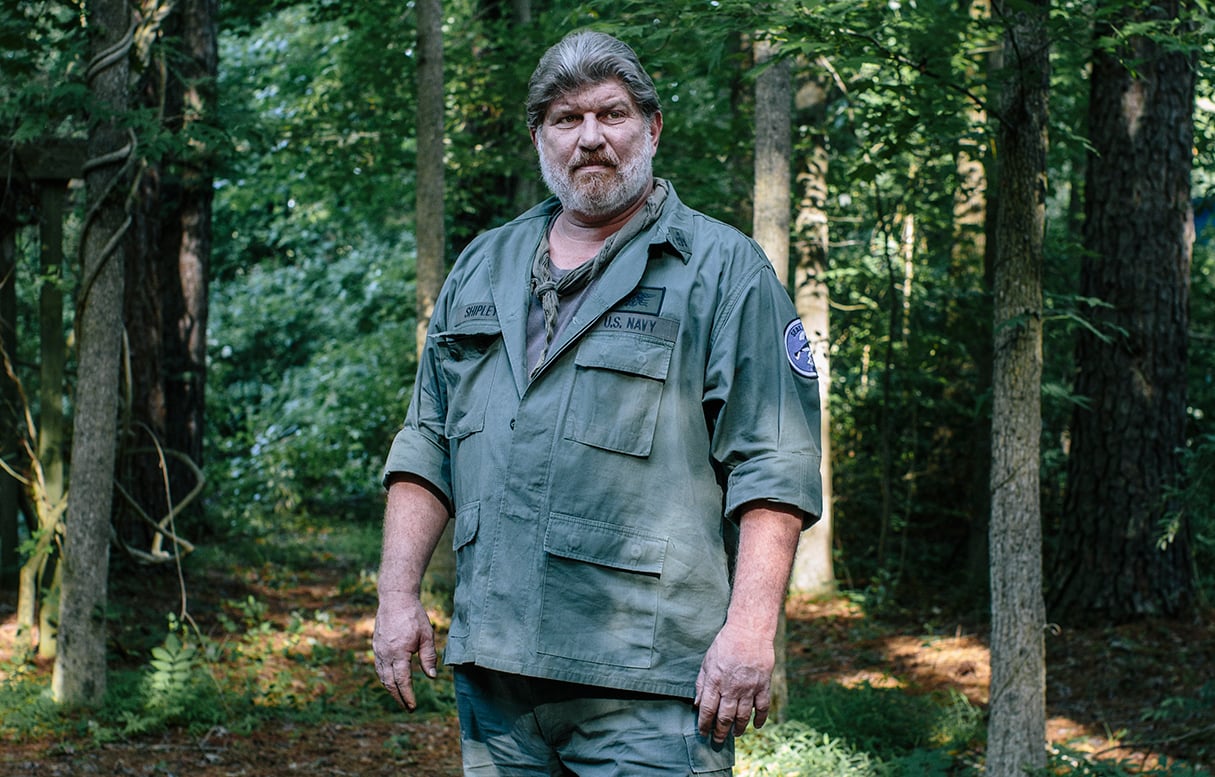The mud feels grimy and viscous, with a greenish tint that makes you think of Superfund sites and names for new diseases. I’m crawling through it on my elbows with 25 other slimy recruits.
“Dicks in the mud!” a drill instructor shouts.
The scene is a boot camp called Extreme SEAL Experience, held in the tidewaters of Chesapeake, Virginia. It caters to young SEAL aspirants, macho fortysomethings, and, on this occasion, an unprepared and out-of-shape reporter. That would be me.
I’m here for Hell Night, a grueling 24-hour marathon that simulates the real SEALs’ infamous Hell Week. Mud plays a big part in both. And the proprietor knows where to find the best mud. His name is Don Shipley, and he was a SEAL for 19 of his 24 years in the Navy—an explosives expert, a platoon chief, and the recipient of a Navy and Marine Corps Medal for heroism. But I found out about him from a badge of honor he acquired more recently: Don Shipley is a YouTube sensation.
Over the past six years, Shipley has exposed people who falsely claim membership in the country’s most fabled military unit, and he has starred in a web series he calls “Phony Navy SEAL of the Week,” in which he ambushes the culprits. Part slapstick comedy, part To Catch a Predator, the show has racked up millions of views and earned a following among Navy brass, too.
While veterans and active military devour Shipley’s vigilante-style justice—the perfect counteroffensive for con men sullying the SEALs’ reputation—you don’t need to have worn a uniform to get sucked in. When I found his little corner of the internet, I resolved to meet him.
I just didn’t realize mud would be involved.
You see, Shipley called me three days before I was set to interview him during a session of his Extreme SEAL boot camp. I thought he might be canceling on me. I was way off.
“Michael,” his voice boomed. “Would you say you’re in shape for your age?”
I’m 27, five-eleven, and weigh a buck-fifty, tops. I haven’t run a mile since high-school gym class or done push-ups for even longer. Also, I’d been subsisting on a ten-pack of hot dogs that week for dinner.
I said yes.
Shipley told me to ditch the hotel room I’d booked, stay in the cabins with the guys. Take part in Hell Night, the whole ordeal.
“Don’t worry,” he said. “I’ll take care of you.”
Once I’m up to my elbows in slime, I realize what he really meant by that.
“I still see some white on that shirt, Gaynor!” he bellows from his perch on the banks.
Shipley decides we’re going to play a little game called Hide the Trainee. The rules are simple: We, the trainees, have to hide ourselves completely. In the mud.
Until this point, I tried to protect my face from the sludge as we churned through it. But now there’s no escape.
“Ready?” he says. “Hide the trainee!”
With that, I lower my head—as well as the aforementioned other anatomical elements—and submerge myself into the weird, wild world of Don Shipley.
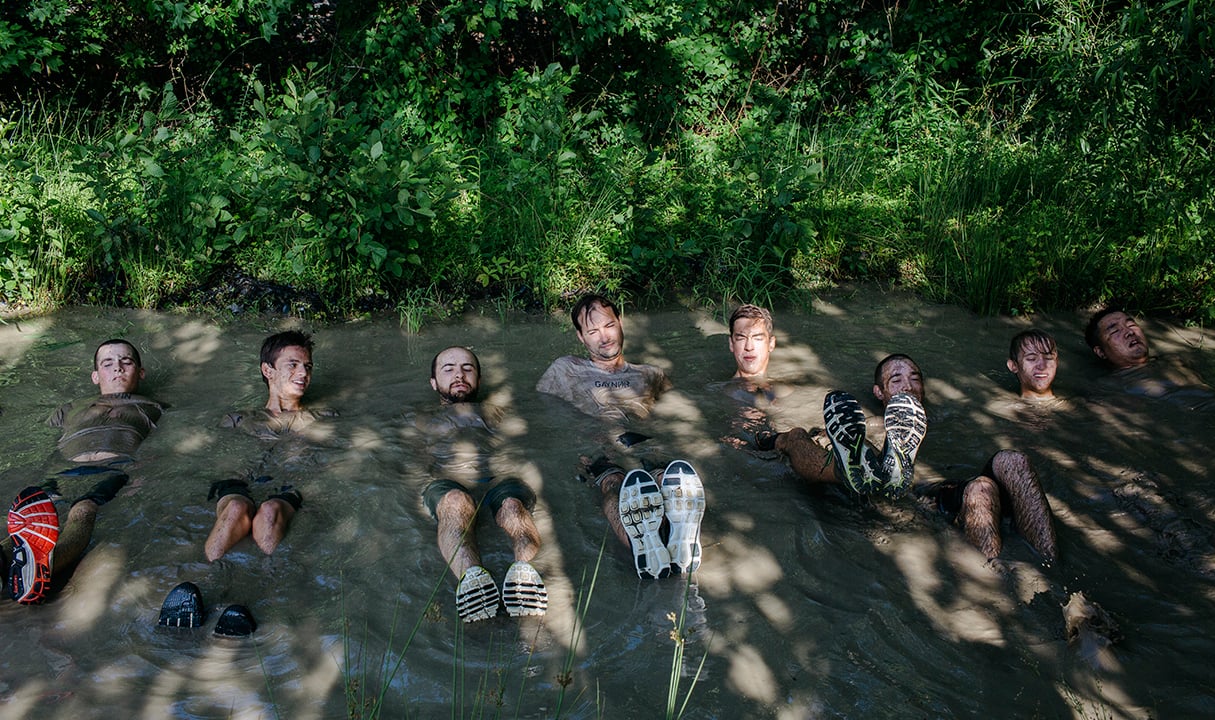
One night this past winter, I came across a genre of online videos that absolutely fascinated me: “gotcha” footage of real military men confronting frauds who were posing as servicemembers or veterans. Stolen Valor, it was called.
Most of the fakers in these clips gave themselves away with careless mistakes of attire—a medal that wasn’t pinned correctly, ribbons that a real Army man wouldn’t wear. The authentic soldiers would close in to shame the impostors, shout about buddies they saw die over there and the memory these pretenders were sullying.
It was brutal to watch. As the hoaxes unraveled, the charlatans backpedaled and stuttered through cringe-worthy excuses as the cameras rolled for all the internet to see. Like rubbernecking past a car crash, I couldn’t tear myself away.
It didn’t take long to find the apparent king of the genre: Don Shipley.
Helmet of hair gleaming in the camera’s lights, Shipley would sit at a desk ratting out fakers over speakerphone. He was loud and frequently hilarious, splicing in hammy clips of himself bickering playfully with his wife about her driving skills or what was for dinner. But it always came back to the phonies. And Shipley was an expert at entrapment.
He would allow the imposters to talk themselves up for a while, flaunt their war stories. Gradually, he’d ask specific questions—Who was your instructor? Why is this medal on your résumé worded incorrectly?—and listen as they tied themselves in knots trying to explain the discrepancies. Eventually, he’d drop the bomb: “What’s your BUD/S class number?”
Short for Basic Underwater Demolition/SEAL, BUD/S is the conditioning-and-tactics class every aspiring SEAL must pass at the start of his career. A test of endurance that pushes applicants to extremes, for 21 weeks. Only a quarter make it through. It’s the be-all, end-all verification of a true SEAL. No SEAL forgets his BUD/S number.
Shipley has a database listing every person who has ever survived the class. He knows who’s lying. But he’ll entertain the phonies’ excuses for a while before blowing their cover. “There are two people here who know you’re lying,” he’ll say. “Me and you.”
Some phonies continue to swear they’re a SEAL—they’ll say their name isn’t listed because they worked on deep-cover, strictly classified shit. That’s why they can’t possibly name anyone in their class. Even if they were allowed, they say, it wouldn’t do any good: They’re all dead, KIA.
But plenty of them wilt, give up the ruse on the spot. One phony swore that he’d erase all his SEAL tattoos that very week.
Whichever way it went, the show was impossible to turn off. Which is how I found myself in my current situation.

The first thing they have you do at Extreme Seal Experience is sign a waiver. I start skimming the fine print. But when I get to the risks of “paralysis” and “death,” I stop reading and scribble my name. No matter what it says, there’s no backing out now.
Most of the other guys are younger and fitter, either in high school or just out. The oldest is a 53-year-old from Brussels (a ripped 53-year-old). There’s a nervous energy in the air, like the first day of summer camp. Hell Night looms large.
So does the “puke rule.” Ten seconds before you throw up, you have to call for the instructors—so they can take a picture of the moment for Facebook.
Shipley hawks his camp as the closest civilians will ever get to authentic SEAL life. His website says, “Here you learn . . . why so many guys fail SEAL Training in the Navy!,” which is apparently a real selling point. “I’m just going through a midlife crisis and wanted to do the most extreme thing possible,” Steve Epperson, a 46-year-old electric-utility CEO from Kansas, tells me. Like all the other guys, Epperson has paid $2,350 for the privilege of getting his ass kicked and his vomit documented.
The camp takes place in and around Shipley’s back yard, in the heart of SEAL country. The commandos who rescue hostages and infiltrate enemy countries covertly, who killed Osama bin Laden and saved Captain Richard Phillips from Somali pirates—their East Coast headquarters is 30 miles away in Little Creek, Virginia. The area is crawling with current and former SEALs, and some work as Extreme SEAL instructors.
When Shipley first materializes at my session, everyone stops what he’s doing to watch. Shipley strides out from the tree line with an enormous ladder balanced on one shoulder and climbs onto a boat the color of gunmetal. His helmet of hair is even bigger than it looked on camera, so thick and unreceded he’s barely got a forehead.
As he pulls gear from the massive vessel, he lists its specs: top speed of 32 knots, two machine-gun mounts, able to stay underwater for three straight days. The so-called reversible submersible is designed to drive SEALs as close to a target as possible above water, then finish the last leg underwater. The security contractor formerly known as Blackwater—where Shipley worked after his Navy retirement—gave it to him, he says.
“So it wouldn’t end up with some Colombian drug lords.
“Thing f—ing hauls ass.”
Shipley climbs down and lines us all up for orientation. “Don’t touch any of the f—ing poison snakes,” he says. “There are four poison snakes on the East Coast, and three of those f—ers are here. One lives under the bunkhouse.”
At 54, Shipley is boisterous and vulgar and doesn’t take any shit. “You’re only allowed two dumb questions a day,” he says when a student approaches him with an inquiry after his talk. “And I keep count.”
The guy’s hair is long like a California surfer’s—he wants to know if he can wear a swim cap tomorrow during Hell Night.
Shipley lets out a big, bewildered laugh: “A swim cap? You’re never gonna get any chicks with a swim cap!” But he’s a benevolent dictator and okays the request.
“Do what you have to do,” he capitulates, before one last dig: “What color is it? Is it yellow? Does it have flowers on it?”
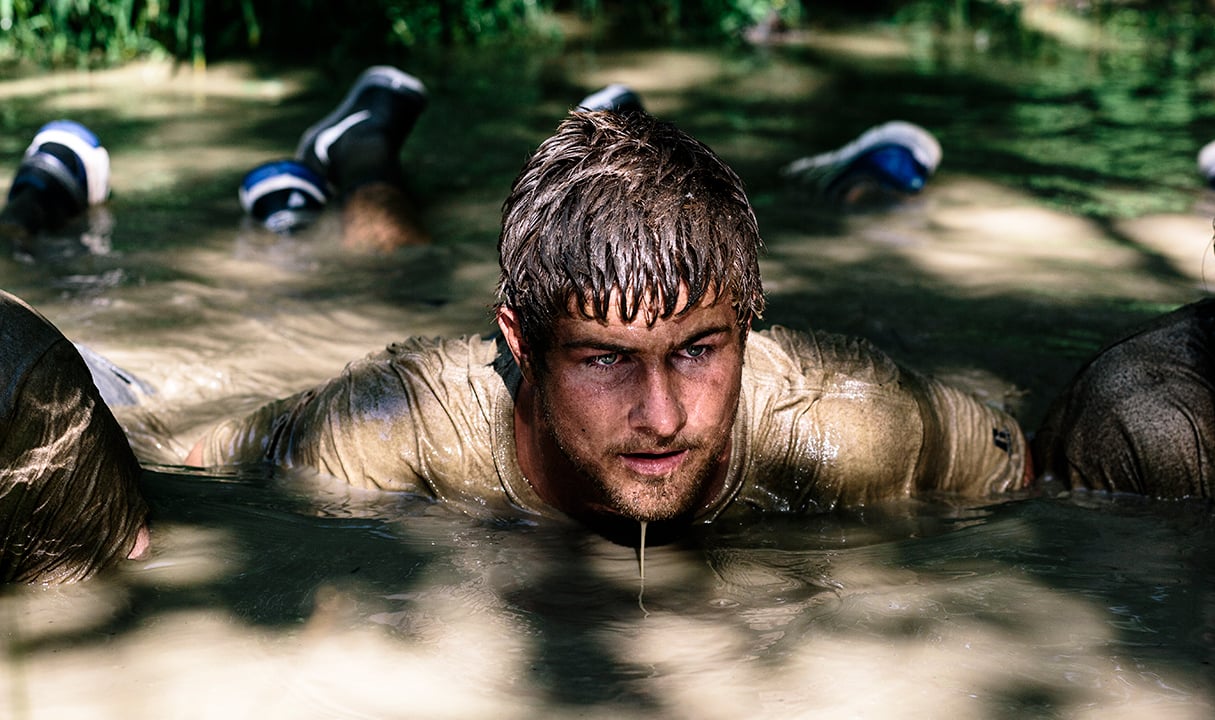
Later that night, we’re all sitting around a campfire slapping the bugs away and trading stories about how we got here. Matthew Rasch, a 24-year-old from New Jersey, signed up for the Army earlier that week. He’d been a toll collector who spent long stretches of idleness watching Shipley online, awaiting new episodes like a Game of Thrones addict. “Did you see the last one?” asks Charlie Pivar, from Florida. “When it’s 3 in the morning and I can’t sleep, I just throw on his videos, one after another.”
Earlier in the day, Shipley ranted about the phony SEALs he’d just busted. One boasted of knifing a polar bear to death during an Arctic expedition. Another told tales about how the Navy showed videos of killing women and kids to “toughen him up.” Shipley didn’t like that one—he’d been talking up the character that time in uniform builds. “That’s why I get so worked up about these phonies,” he said, “ ’cause they wreck all that shit.”
Shipley’s fake-SEAL policing started six years ago, when a former Marine wanted to donate two sniper rifles to Shipley’s camp. The man said he was disabled after his helo got shot down over Panama, and Shipley made a point of toasting him in front of a class. But there was something fishy about the guy. He was obese, unkempt—un-Marine-like.
Shipley used a Freedom of Information Act request to pull his records. Turned out the guy had never been in Panama, never been shot down—he’d never even been in combat. “It was total bullshit,” says Shipley, who had lauded the faker as a hero. “And I just got really f—ing mad.”
This was 2009—America had been at war in Afghanistan for eight years, in Iraq for six. More than 5,000 servicemembers had come home in caskets. The public shaming was a way to inflict the most humiliating form of punishment. He wanted people to know the phrase “phony Navy SEAL.”
“The guys that are no longer with us and can’t stand up to defend their honor—I’m gonna f—ing defend it for you,” he says. “I like fighting. Whether it’s with a keyboard or my colorful past in the Navy, I like fighting.”
Today Shipley gets more than 150 verification requests a week. Parents will e-mail him about a sketchy guy their daughter’s dating. Former military will Facebook him about a new colleague whose Navy stories don’t ring true. He says Jay Leno inquired about two employees a few years ago.
The most outrageous outings end up as videos. Like the guy who audaciously claimed to have trained Marcus Luttrell, immortalized in the book and movie Lone Survivor for being the only SEAL to survive a brutal ambush by the Taliban in 2005. The phony told Shipley that Luttrell panicked during swim training. So Shipley got both men on the phone for a three-way conversation, which, understandably, did not go well for the phony.
Protecting the legacies of guys like Luttrell—as close to Navy SEAL royalty as they come—has made Shipley a celebrity in commando circles, but also among those who dream of joining the club.
“I was starstruck when I first saw him,” I hear one of the Extreme SEAL students say. Another mentions his amazement when he called the camp phone number and Shipley himself picked up.
Our campfire is struggling when Shipley and his wife and YouTube costar, Diane, speed over in a golf cart for a little ribbing before bed. “I could have a baby by the time you get that lit,” Diane says as a kid blows futilely on the fading embers.
Shipley talks up past graduates, calling them “you guys” while pointing at us. It’s strange at first but makes sense as the message turns to the camaraderie he assures us will develop during tomorrow’s Hell Night. Especially when we puke. “We had one of you guys come through here last year,” Diane says, “and when he threw up, it looked like potted meat, I’ll tell you.”

The next morning, people are up before sunrise, stretching and debating which breakfast items aren’t likely to resurface later. The day starts at 0700 hours—at 6:55, we line up. Shipley warned us that arriving five minutes early is on time. Arriving on time is late.
The others are clearly excited to get going. I’m regretting giving up my hotel. Shipley is walking the line, promising that the next 24 hours will be the hardest of our lives. We won’t sleep, pretty much like in a real SEAL’s Hell Week.
“You’re a bunch of strange guys to be here,” Shipley says. “You’re weird. Everyone else is back home sleeping one off.” There’s pride in his voice. Weird is good.
Within minutes, we’re all face-down in the dirt for push-ups, the first conditioning of the day. I can’t really remember what a “good” push-up looks like, but I know whatever I’m doing isn’t it. We’re supposed to keep going for two minutes, but 30 seconds in, my ass is arched so high my body looks like an Egyptian pyramid.
The real BUD/S screening test requires, among many other terrible things, a minimum of 50 push-ups in these two minutes, a target I miss by multiples of multiples. After a 15-minute run through the woods, it’s time for the day’s first maritime exploit. For most military units, water is an obstacle. But to SEALs, water is home. The first SEALs fought in the canals of Vietnam, a few years after President Kennedy formed the unit. They wore pantyhose beneath their camo to ward off leeches and painted their faces swamp green, their amphibious stealth so fearsome that the Vietcong told ghost stories of the “devils with green faces.”
Our task is a long swim. Two lengths of a wide-open lake. Likely nothing more than a brisk paddle to real SEALs, who learn how to glide like a fish with a “combat sidestroke” that can keep them alive over miles-long littoral treks. I’m no fish—flailing and gulping water, my arms weak from the push-ups.
On the other hand, I’m not the kid onshore wiping breakfast off his chin.
Proud that my puke won’t be the first to hit Facebook, I follow our instructors on another run through the woods. The lake felt good, cooled me down. I start to think that maybe this won’t be so bad after all. Until we stop suddenly and I see it for the first time. The mud.
And there’s Shipley, standing on the other side of the putrid pool, ready for a round of Hide the Trainee.
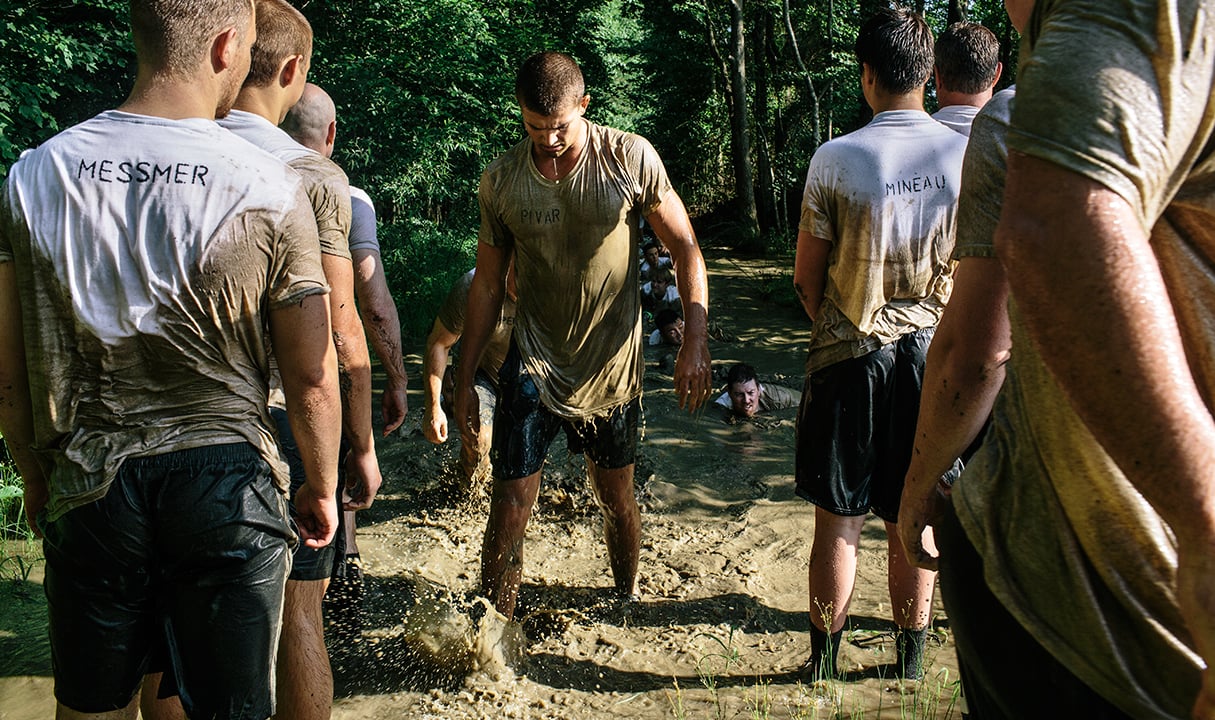
“We like the suck,” says Shipley, explaining what motivates SEALs to crawl through mud. “We don’t like it when it’s happening, but we like it after the fact. Some of the insane stuff that we do, days on end, in the desert—what you really remember is how bad things were and the guys that you shared it with.”
Shipley spent his childhood hunting and trapping on his family’s Pennsylvania cattle farm. When he was 16, his father, a fighter pilot turned airline captain, moved the family near Easton. Shipley felt he didn’t fit in there. With his parents’ permission, he quit school to join the Navy. “Next thing, I was getting tattooed in Hong Kong at 17.”

After 32 months at sea, he transferred back to the States and landed on one of the first Navy ships with women aboard, which is where he met Diane. Shipley eventually found himself stationed in Coronado, California, where he got his first glimpse of the SEALs at their West Coast headquarters. “I remember asking somebody, ‘Who are those guys?’ ” he says. “At that point, there were no books written about SEALs, there weren’t any movies. You heard crazy stories and hushed shit about it. But I just thought it looked cool.”
As a SEAL, Shipley went to postwar Bosnia to transport people wanted for war crimes to Geneva for trial. He helped guard the US Embassy in Liberia after it was attacked by gunmen. In 1996, a mechanical explosion caused a massive fire on a merchant marine vessel near West Africa. Shipley rappelled out of a helicopter to rescue the burning ship’s stranded crew. That’s how he won his heroism medal.
“We were the only option,” he says. “Eight of us went onboard in the flippin’ middle of a typhoon and stayed with ’em for 18 hours. Evacuated as many as we could, cleared out the dead, tried to keep the ship afloat. It was a real mess. Coolest thing I ever did.”
By comparison, life after the SEALs can seem a letdown. Many retirees end up in a boardroom, drafted by a business world attracted to their cachet. Not Shipley. He wanted to stay in the suck. After retiring in 2003, he worked for Blackwater in Pakistan and Afghanistan. Then he started his boot camp, recreating the rarefied world he loved so much.
Hunting down phonies was initially just another way to preserve that world. Then it became entertainment, too. At one point, Shipley says, some Spike television executives liked the To Catch a Predator aspect of his series and approached him with a deal. But they pulled the plug before the pilot came together.
Shipley claims it would be hard for reality TV to woo him again. “They gotta at least have as much balls as I do or I’m just not even remotely interested,” he says. “And they don’t.” But watch him on camera—the way he rolls his eyes for the audience as a phony prattles on, the sudden cutaways to his BS-ing with Diane—and you can see how much he relishes the act.
For now, Shipley is professionalizing the show himself with a new content site. For $10 a month, you can surf channels such as Ask Don and Diane Shit and watch a slicker version of “Phony Navy SEAL of the Week.” The backdrop is no longer Shipley’s living room. He says the phonies caught on to his MO and hung up when they recognized his voice or caller ID. So instead of speakerphone, Shipley now confronts his targets in person, cameramen in tow.

It’s not like you dunk your head in the mud once during Hide the Trainee and you’re done. Shipley has us “hide” again and again. My sneakers are clogged with slime, making the butterfly kicks they force us to do all the more taxing. Each time I surface, I shoot brown snot from my nose and spit out muck that tastes like sour milk. It is the real suck.
“To survive Hell Week, a trainee has to do two things,” retired SEAL Dick Couch wrote in The Warrior Elite, “take the punishment being dished out, and get past thinking about the punishment to come.” This translates into a SEAL mantra: Just make it to the next meal.
In my case, that means forgetting it’s only 10 am. Or that the obstacle course is up next. Forget about how much it hurts to hurl medicine balls and sprint across a sun-cooked field wearing a mini-parachute for wind resistance and a 20-pound weight vest just because.
Just think about chow time. Hopefully it’s not hot dogs.
Shipley started Extreme SEAL Experience in 2006, expecting to cater only to Navy candidates. He was surprised when his first class included a middle-aged South African carpet maker. Older guys, foreign guys, people who had no intention of actually joining up. Vietnam vets have passed through, as have three pastors and a guy who was nearly blind. Women aren’t allowed to be SEALs, but one did come through Shipley’s camp—a fellow YouTube personality.
More than 350 people attend each summer. Some return—a member of my class was on his fourth tour. But every year, one or two drop out. They’re often the young guys, the ones who grew up playing Call of Duty and picturing combat-action ribbons in their future. “The dream is dead,” Shipley remembers one telling him. That summer, one of the instructors was a SEAL whose bicep was destroyed by an AK-47 round in Iraq. Aspiring SEALs see that, Shipley says, and “realize this isn’t a video game.”
He’s proud of his low dropout rate but wants it lower. There are no instructors screaming in your face at Extreme SEAL Experience, no malicious intent to the drills. “I got guys f—ing coming from Brussels, from China,” Shipley tells me. “To have that guy fail? And go all the way back to China?”
During the afternoon, we get lessons in prisoner handling, clearing a room, and knife fighting (SEALs have been known to carry tomahawks for hand-to-hand combat). Relatively easy stuff. That is, until I hear Shipley shout, “Log PT!”
Log PT (the PT is short for “physical training”) is another SEAL tradition, appropriated from WWII-era British commandos who exercised with telephone poles. It’s about teamwork, each man draining himself to carry his part of the weight. SEALs call it the closest you’ll get to seeing God.
We have to lift a log onto our right shoulder, then down the left. Caterpillar one between our legs. Kick another across a field as we race on our asses to the other side. Each team rotates logs, dreading the short, fat specimen named Ol’ Misery that weighs 350 pounds. “Come on, you know you want to give it up!,” I hear at one point when my team is fighting to keep the log above our heads the longest.
Win one challenge and you get to sit another out. It’s a common motivating tactic in SEAL training, where the saying is “It pays to be a winner.” To me, it seems like the rich getting richer. While my elbows are quaking under the weight of Ol’ Misery, another team relaxes, no doubt regaining strength to win the next challenge, too.
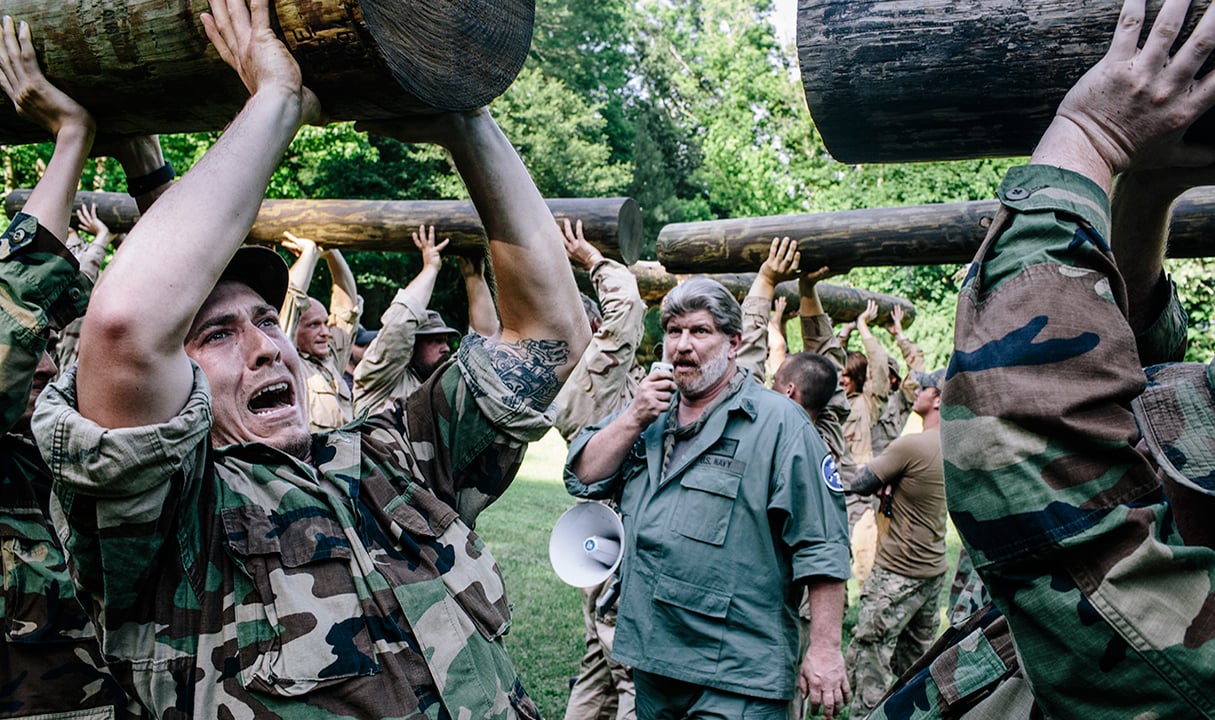
Before 9/11, there were only about 1,500 active-duty SEALs, according to Couch’s book. Because of the need for more bodies in Iraq and Afghanistan, today’s force is more like 2,500, compared with 326,000 overall in the Navy. The elite unit is still extremely small, in other words.
But when SEALs make the news for a heroic mission like the bin Laden raid or a SEAL-penned memoir like American Sniper becomes a bestseller, the posers come out of the woodwork. Two years ago, Shipley’s verification requests started coming in so fast that he began charging $20 a pop.
“I’m sure there were phonies who claimed to be the sole survivor of Thermopylae,” Shipley says. “Guys that claimed service at Gettysburg, Valley Forge. But they could only project it down a couple of barstools at the village pub. Now with the internet, you can be anyone you want to be.”
According to Shipley, there are phonies who lie to scare their girlfriends into staying in abusive relationships. “I deal with a lot of women who are terrified of these guys,” he tells me. The average poser is merely out for sex, free drinks at the local bar, or just a nice ego stroke.
“People look for some deep-seated reason why they do this,” says Doug Sterner, a Vietnam veteran and fellow fake-soldier hunter. “But I go back to that old comment about asking a bank robber why he robs banks. ’Cause that’s where the money is.”
In 1998, Sterner began compiling a public database of Medal of Honor winners. Before long, people called to ask why someone wasn’t listed. It must be because he’s lying about winning the medal, Sterner would reply. His database for commemorating heroes soon became one for exposing charlatans.
For years, you could pose as a vet with little fear of punishment. Sterner and his wife helped fix that. She started a lobbying push for a federal law, and in 2006 President Bush signed the Stolen Valor Act, which criminalized lying about military records. The FBI went after a variety of offenders—the Louisiana man who allegedly claimed to have a Purple Heart in order to get a special license plate, the Virginia county commissioner found guilty of lying to receive disability benefits.
But in 2012, the Supreme Court struck down the law, calling the lies protected free speech. The following year, Congress passed a watered-down Stolen Valor Act that made it illegal to fake certain credentials, but only if done for tangible benefit. Sterner believes the law is weak, and enforcing it is not a high priority. (When I asked an FBI representative how many Stolen Valor cases it has worked, I was told the numbers “are not readily available.”)
That means the only sanction some fakers will face is Shipley’s vigilante justice. Most will likely continue to get away with it. That’s because for the average citizen who tries to verify someone’s military service, the process isn’t exactly straightforward. I know because I decided to turn the tables and look up Don Shipley myself.
The instructions I either found or got—from the National Archives and, later, the Navy Personnel Command—were both dense and conflicting. One fax I was told to send vanished into the bureaucratic ether. Frustrated, I called the Navy press liaison (yes, I realize this is cheating a little bit), who said I should write to its Freedom of Information Act office, even though that’s not advertised as the optimal route. I waited almost three weeks for heavily redacted documents confirming Shipley’s military service to arrive. (He was indeed a SEAL.)
When Shipley does it, he has an advantage: the SEAL database. Would-be SEALs might think they could hide behind the unit’s code of silence and the classified nature of its work, but because Shipley has decades’ worth of names and BUD/S class numbers—18,000 and counting—he can take down a phony almost instantly.
How does Shipley keep tabs on each new cohort of SEALs? He says a network of fellow phony-hunters—mostly former SEALs—feeds him updates with each new class: “A lot of people find this hard to believe, that there’s a list of these guys, because it seems so secretive, but that’s bullshit—there are records kept, and we have ways to access them.” (The Navy SEALs press office doesn’t comment on the actions of its former members.)
Shipley likes to point out that his method is endorsed by the Navy brass. A few years back, he got a call from a woman looking to vet her boyfriend’s purported SEAL credentials. She’d been referred to him by her boss, a high-ranking admiral. “Instead of putting her through the red tape,” he tells me, “he said to ‘call Shipley to hook you up.’ ”

By 2100 hours, night has fallen on base camp and it’s time to go on a mission. We’re going to infiltrate a building. The first team will use its new prisoner-handling skills to capture a high-value target. Mine will plant a pretend bomb. (Just as well, because during the prisoner-handling lesson, I was more likely to find myself being handled.)
We smear paint on our faces and strap on fake machine guns. Shipley explains that the mission requires us to go off-property, first in small Zodiac boats, then on land. Should we encounter a policeman, he warns, tell him you’re with Don Shipley. And take your hands off your weapon.
“Also, when you’re in the boat, watch out for drunk f—ing catfishermen,” he says. “You’re dressed in camo on a black boat in the dark, and they will plow right into you.”
The “fake” mission is suddenly feeling alarmingly real.
We launch our Zodiacs into the night and start paddling down a boggy stretch of the Northwest River in silence. For all we know, there are hostiles lurking somewhere in the quiet deep, instructor Shipley planted to sabotage us.
The extreme conditioning we did all day has drained us. The point now is to test our abilities even in this deteriorated state. After docking the boats, we proceed on foot into a forest. Not a glimpse of moonlight penetrates the treetops. No trail, either—just thickets of tangled branches that we have no choice but to press through. I can’t see six inches in front of me, and it seems like miles before we rendezvous with the other team. I start to fantasize that if we finish on time, we’ll get to take the rest of the night easy. But even in my delirium, I know that’s unlikely.
Suddenly, it’s go time. We breach the building’s gate. I hear someone yell, “Bang!”
The first team moves inside to get their man, while mine dashes to the perimeter to plant the bomb. We meet back outside, and the target window closes with minutes to spare. Mission accomplished.
Of course, the night isn’t over. It’s past midnight, and the temperature is falling fast. Perfect conditions (to our instructors) for a dip in the pool. But this time, the objective isn’t to swim—it’s to sink. We need to tie ourselves up at the wrists and ankles, drop down to the bottom, and figure out how to come back up.
The rationale: Say your elbow or knee is shot off—you still gotta know how to get to the surface. SEALs call it “drown-proofing.”
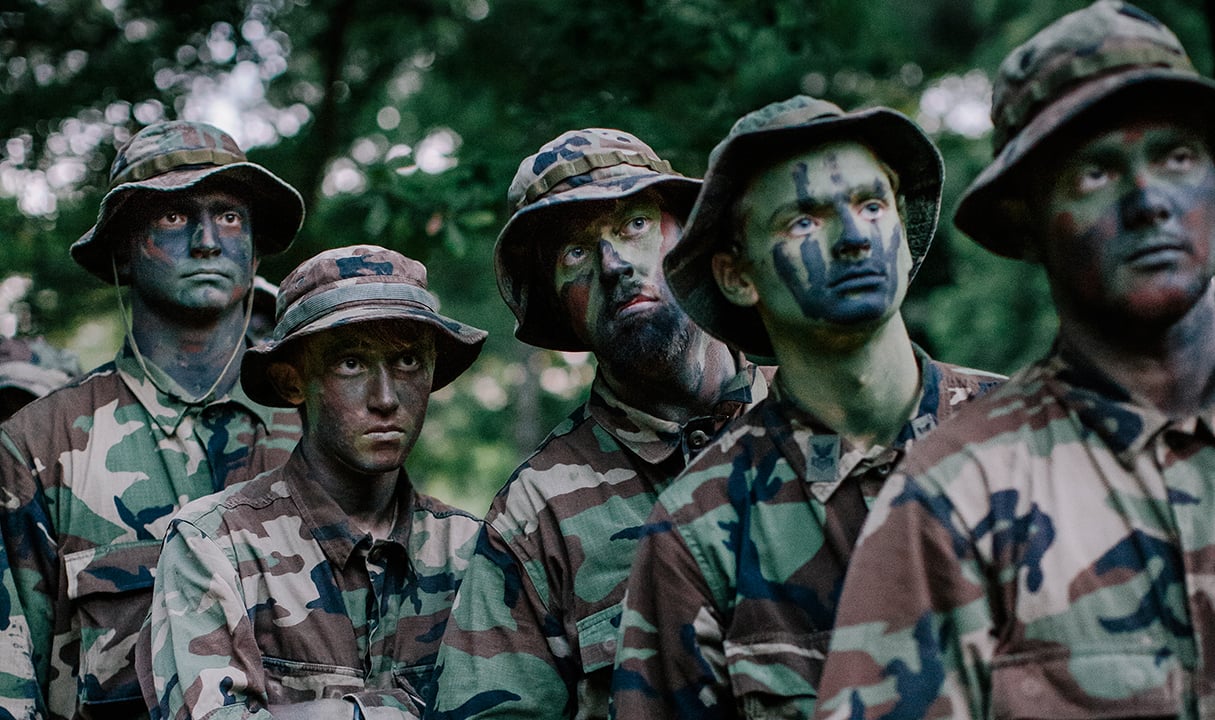
This past Memorial Day, a 75-year-old retired Marine named Robert Ford walked through a festival in Harrisburg, Pennsylvania. He had just attended a wreath-laying ceremony and was wearing his old uniform. As he shopped for presents for his granddaughter, a police officer and a soldier approached.
They asked Ford for specifics about his service, implying they didn’t believe he was a veteran. “Stolen Valor! This man is a fake!” the soldier shouted, according to the local paper. A television crew appeared.
The accusers had been drawn to Ford’s belt, which they said looked too ornate for the uniform. But Ford really was a Marine. “I was humiliated,” he told the newspaper.
Shipley tells me he’s never made that kind of novice mistake. “Like, what’s your f—ing problem, man?” he says.
Yet the internet is full of amateur Stolen Valor videos. Instead of Shipley’s polished film, these show camera-phone footage of harassment and threats. People are shoved and slapped. It’s hard to tell what’s going on. Once Shipley posts a video, he says, he never contacts that phony again. Others don’t follow that same code. “Some guys, there’s such a bloodlust,” he says. “They hide behind a screen and harangue [the phonies’] families, their mothers.”
You might expect a man like Shipley to act aggressive when confronting phonies, but he keeps it surprisingly cool. There’s little swearing, only the occasional threat, and he has a rule to not write in all caps. “What [the phonies] are doing is bad,” he says. “Don’t make us look bad undoing them.”
Still, the situation can get out of his control. In September 2012, one of Shipley’s targets was Ike Densmore of California. Densmore claimed an illustrious military history, including three Purple Hearts. When he identified an instructor as one “Master Sergeant Andrew Smith,” Shipley called him out. The Navy doesn’t have master sergeants.
More than 150,000 people watched that episode. A California TV station picked up the story. Two months later, Densmore was found dead on a remote beach with a self-inflicted shotgun wound. “I still feel funny about it,” Shipley says. “I felt strange. It’s definitely a setback when something like that happens, guys taking matters into their own hands . . . .” He trails off.
Lately, Shipley tells me, the work has become more taxing. He and Diane still laugh and banter in the clips, trying to find humor in their depressing pursuit. “But we’re both overweight, we drink too much, our blood pressure’s up,” he sighs. Wading through lie after lie takes its toll: “You get so wrapped up in these guys, you have a hard time stopping to go to bed at night.”

It’s after 2 am when we leave the pool and board a bus we thought was going back to Shipley’s. One by one, the students drift into a cautious sleep, the first rest we’ve had all day.
Until the brakes squeal to a stop and someone yells, “Everybody out!”
Another swampy lake in front of us.
And I was almost dry.
It’s here that we make our final stand of Hell Night. We swim the lake from end to end, sprint to land, do more exercises, run back into the water. Then all over again, an endless cycle of soggy exhaustion.
The “dicks in the mud” instructor from earlier fires a frigid hose at us as we do push-ups on hard gravel. We do squats against a fence, trying not to be the first ones to fall—they get more push-ups, more frigid hose.
“I could’ve been on a beach in Thailand right now,” Marc Hines groans as we press our backs against the fence. “My son wanted to come here for vacation instead.” He nods to his 19-year-old kid, Jake, who’s on the other side of me goading his dad into falling first.
Finally, we line up in formation facing the lake. I can tell this is it—we’re almost done. Then Shipley calls my name, tells me to step out and face the group.
He orders me to lead the final exercise: push-ups. The same way the day started.
We drop to the ground, and I begin to yell out the count. I can barely hold myself up. My elbows feel like crumbling fossils. But as I count, I hear my fellow students call back in unison. Their echo quiets the pain, energizes me, and although I can barely gulp a breath by the end, I finally howl out the last push-up.
That’s it. Hell Night is over. And I didn’t even puke.
The boats we took earlier are waiting at the water’s edge, ready to sail as the sun begins to rise. First, Shipley walks the line one last time, shakes our hands, congratulates us one by one. We may be phonies, but we’re the genuine kind.
Staff writer Michael J. Gaynor can be reached at mgaynor@washingtonian.com.
This article appears in our September 2015 issue of Washingtonian.

